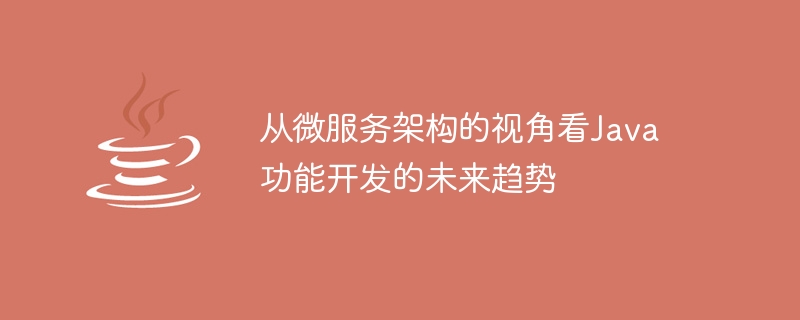

Looking at the future trend of Java function development from the perspective of microservice architecture
Abstract:
In recent years, with the development of cloud computing and big data technology With the rapid development, microservice architecture has become the first choice for most enterprise software development. This article will explore the future trends of Java function development from the perspective of microservice architecture, and analyze its advantages and challenges with specific code examples.
With the continuous expansion of software scale and rapid changes in business, monolithic applications have gradually exposed the problem of being unable to meet modern development needs. The concept of microservice architecture provides a new solution to this challenge. Microservice architecture splits complex systems into small, independent service units, each of which is responsible for completing a specific function. As a widely used programming language, Java also needs to continuously adapt to the development of this architectural change.
2.1 Based on Containerization Technology
Containerization technology (such as Docker) provides deployment and management of microservices Provides strong support. Java applications can also be packaged into an independent container and can be flexibly deployed and run in different environments. This approach not only improves development efficiency, but also makes better use of resources.
Sample code:
package com.example.microservices; import org.springframework.boot.SpringApplication; import org.springframework.boot.autoconfigure.SpringBootApplication; @SpringBootApplication public class MicroservicesApplication { public static void main(String[] args) { SpringApplication.run(MicroservicesApplication.class, args); } }
2.2 Based on cloud native development
Cloud native development emphasizes decoupling applications from underlying infrastructure, making applications more elastic and scalable sex. Java applications can better adapt to the needs of cloud environments by using cloud-native development frameworks (such as Spring Cloud) to implement service registration, service discovery, load balancing and other functions.
Sample code:
package com.example.microservices; import org.springframework.boot.SpringApplication; import org.springframework.boot.autoconfigure.SpringBootApplication; import org.springframework.cloud.client.discovery.EnableDiscoveryClient; @SpringBootApplication @EnableDiscoveryClient public class MicroservicesApplication { public static void main(String[] args) { SpringApplication.run(MicroservicesApplication.class, args); } }
2.3 The rise of asynchronous programming
In a microservice architecture, communication between services generally uses asynchronous methods to improve performance and scalability . The Java language has introduced functions such as CompletableFuture and Stream API since Java 8, making asynchronous programming more convenient and efficient.
Sample code:
package com.example.microservices; import java.util.concurrent.CompletableFuture; public class MicroserviceClient { public CompletableFuture getDataAsync() { return CompletableFuture.supplyAsync(() -> fetchDataFromService()); } private String fetchDataFromService() { // 执行异步数据获取操作 return "Data"; } }
3.1 Advantages
3.2 Challenges
Microservice architecture provides more choices and challenges for Java developers. Through technologies based on containerization, cloud native development and asynchronous programming, Java development can better adapt to the development trend of microservice architecture. However, Java microservice development also faces complexity and coordination challenges, requiring developers to design and tune accordingly.
References:
The above is the detailed content of Looking at the future trend of Java function development from the perspective of microservice architecture. For more information, please follow other related articles on the PHP Chinese website!
